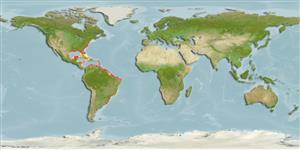Lunarca ovalis (Bruguière, 1789)
Blood ark| Native range | All suitable habitat | Point map | Year 2050 |

|
| This map was computer-generated and has not yet been reviewed. |
| Lunarca ovalis AquaMaps Data sources: GBIF OBIS |
Classification / Names Common names | Synonyms | CoL | ITIS | WoRMS
Bivalvia | Arcida | Arcidae
Environment: milieu / climate zone / depth range / distribution range Ecology
Benthic; depth range 0 - 68 m (Ref. 104365). Tropical, preferred 25°C (Ref. 107945); 43°N - 35°S, 98°W - 33°W (Ref. 3446)
Distribution Countries | FAO areas | Ecosystems | Occurrences | Introductions
Western Atlantic: from Cape Cod, Massachusetts, to the West Indies and Brazil.
Length at first maturity / Size / Weight / Age
Maturity: Lm ? range ? - ? cm Max length : 7.6 cm SHL male/unsexed; (Ref. 78146)
Short description Morphology
Equivalved, oval in shape. Size range: 2.8-7.6 cm shell length. Shell length to height ratio = 1.16 (Ref. 78148). Shell depth reaching 70% of height (Ref. 78152).
In the USA, this species remains a potential fishery resource. From the late 1990s to early 2000s, wild stocks of this species are the target of a small-scale fishery in North Carolina (Ref. 78154) and the eastern coast of Virginia with exports primarily as ethnic food to Chicago, New York, Los Angeles and Washington D.C. (Ref. 78152).
Life cycle and mating behavior Maturity | Reproduction | Spawning | Eggs | Fecundity | Larvae
Sexes are separate with low incidence of hermaphrodism (2.17%). Males dominant (m/f=2.68). Peak in gonadal pattern in late spring to early summer (45% ripe in May) and a minor peak in winter (21% ripe in December). Dribble spawning likely strategy to extend spawning period and increase reproductive success.
Main reference
References | Coordinator | Collaborators
Turgeon, D.D., J.F. Quinn Jr., A.E. Bogan, E.V. Coan, F.G. Hochberg, W.G. Lyons, P.M. Mikkelsen, R.J. Neves, C.F.E. Roper, G. Rosenberg, B. Roth, A. Scheltema, F.G. Thompson, M. Vecchione and J.D. Willams. 1998. (Ref. 1667)
IUCN Red List Status (Ref. 130435: Version 2024-1)
CITES status (Ref. 108899)
Not Evaluated
CMS (Ref. 116361)
Not Evaluated
Threat to humans
Harmless
Human uses
Fisheries: minor commercial; aquaculture: experimental
FAO - Fisheries: landings | FishSource | Sea Around Us
Tools
More information
Trophic Ecology
Ecology
Population dynamics
Life cycle
Distribution
Human Related
Aquaculture profile
Stamps, Coins Misc.
Stamps, Coins Misc.
Outreach
References
Internet sources
BHL | BOLD Systems | CISTI | DiscoverLife | FAO(Fisheries: ; publication : search) | Fishipedia | GenBank (genome, nucleotide) | GloBI | Gomexsi | Google Books | Google Scholar | Google | PubMed | Tree of Life | Wikipedia (Go, Search) | Zoological Record
Estimates based on models
Preferred temperature
(Ref. 115969): 14.5 - 28, mean 25.4 (based on 490 cells).
Resilience
(Ref. 69278):
High, minimum population doubling time less than 15 months (K=0.45; tm=5).
Nutrients : Calcium = 149 [71, 228] mg/100g; Iron = 8.53 [1.95, 15.11] mg/100g; Protein = 9.88 [8.64, 11.12] %; Omega3 = 0.313 [0.202, 0.423] g/100g; Selenium = 61 [50, 72] μg/100g; VitaminA = 0 μg/100g; Zinc = 2.04 [0.56, 3.51] mg/100g (wet weight); based on nutrient studies.



